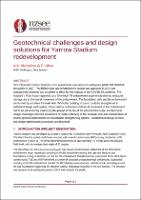| dc.contributor.author | Murashev, Alexei | |
| dc.contributor.author | Alves, Paulo | |
| dc.date.accessioned | 2023-02-21T01:18:15Z | |
| dc.date.available | 2023-02-21T01:18:15Z | |
| dc.date.issued | 2022-04-27 | |
| dc.identifier.uri | https://repo.nzsee.org.nz/xmlui/handle/nzsee/2499 | |
| dc.description.abstract | New Plymouth Yarrow Stadium’s two grandstands were declared earthquake-prone and closed in 2017-2018. The $50m repair and refurbishment project was approved in 2019 and subsequently reviewed and modified to allow for the impacts of the COVID-19 pandemic. The Stadium’s West Stand supported on a 12 m high fill embankment experienced seismic structural damage due to the lateral movement of the embankment. The foundation soils and the embankment are formed by sensitive Taranaki Ash. While the building structure could be strengthened to withstand design earthquakes, future seismic settlement and lateral movement of the embankment had to be prevented by improving the ground at the toe of the embankment slope. Geotechnical design challenges included assessment of cyclic softening of the Taranaki Ash and consideration of several ground improvement and foundation strengthening options. Geotechnical design process and design optimization procedures are described. | |
| dc.language.iso | en | |
| dc.publisher | New Zealand Society for Earthquake Engineering | |
| dc.relation.ispartofseries | 2022;111 | |
| dc.subject | Advancements in structural and geotechnical design and assessment | |
| dc.title | Geotechnical challenges and design solutions for Yarrow Stadium redevelopment | |
| dc.type | Article | |

